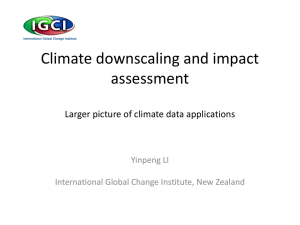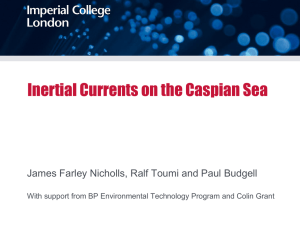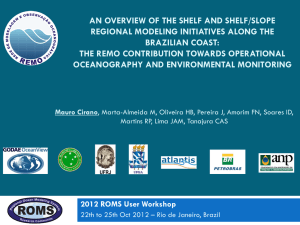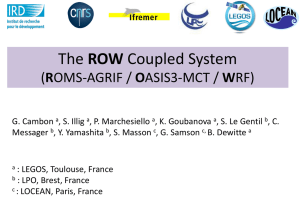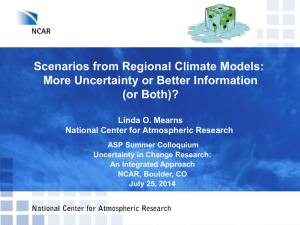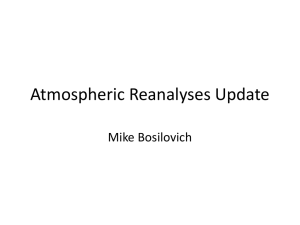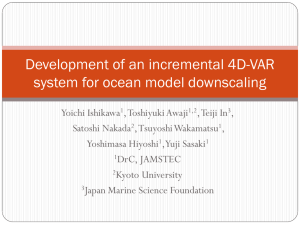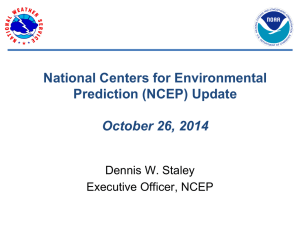PPT - Roms
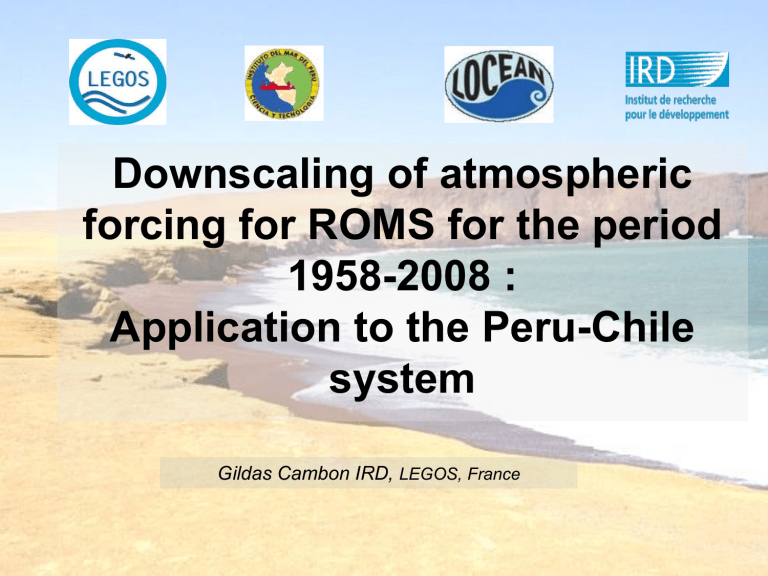
Downscaling of atmospheric forcing for ROMS for the period
1958-2008 :
Application to the Peru-Chile system
Gildas Cambon IRD, LEGOS, France
1
ROMS_AGRIF development team:
Cambon, G. (a) , Marchesiello, P. (a) ; Debreu L. (b) ; Penven P. (c)
(a) : IRD/LEGOS, France ; (b): INRIA/LJK, France ; (c) : IRD/LPO, France
Application Humbolt : PEPS project (ANR)
Gildas Cambon (a) , Boris Dewitte (a,c,d) , Katerina Goubanova (a,d) , Vincent Echevin
(a) , Christophe Hourdin (b) , Ali Belmadani (b) , Timothée Brochier (b ) , Colas Francois
(e)
(a): IRD/LEGOS, France ; (b): IRD/LOCEAN, France ; (c): IGP, Peru ; (d) : IMARPE, Peru ;
(e) : IGPP, UCLA, USA
2
ROMS_AGRIF general context
ROMS_AGRIF is a branch of ROMS developed in France by IRD and
INRIA and based at LEGOS, Toulouse.
Its main particularity is the AGRIF online nesting capability ( Debreu et al, 2005, 2010 ) : http://roms.mpl.ird.fr
This French branch of ROMS is developed to respond to the objectives of IRD in terms of support to developing countries.
In this community experiment, the model code is developed in parallel with a powerful pre- and post- processing set of tools: the
ROMSTOOLS matlab toolbox (Penven et al, 2008).
3
ROMS_AGRIF general context
A world-wide community of users :
Today, the ROMS_AGRIF community well spread developed around the world, with more than 1100 registered users.
A more restricted community of about 40 beta testers exist also and is referenced on our SVN development website at INRIA: http://gforge.inria.fr/projects/romsagrif .
Here we present an application of
ROMS_AGRIF for the Peru-Chile current system conducted in collaboration with Peruvian partners.
4
Outlines
1. Introduction & Issues
2. The statistical atmospheric model
3. The interannual ROMS simulation
4. Impact of the stat. downscaling
5. Perspectives
6. Summary & Conclusions
5
Introduction & Issues
Scientific context & main objectives
Humboldt Current system (HSC) is the most productive eastern boundary current system with permanent upwelling.
Its fisheries represent about 20% of world wide marine fish catch.
There is a need for evaluating the impact of regional climate variability on the Peru-Chile upwelling system
In this context:
Use of global model simulations of the recent past (1958-present)
ROMS is use for oceanic downscaling
Downscaling methods for atmospheric forcing are needed.
6
Introduction & Issues
Strategy
• Interannual regional configuration of ROMS_AGRIF at 1/6° from 1958 to 2008 period.
• For the moment, hind casts over a test period 1992-2005 to evaluate the realism of the solution and 98 El Nino event.
• Set up of atmospheric downscaling methods
Atmopheric downscaling strategy :
AOGCM model needed for these long periods : NCEP, ERA …but large errors are found in coastal areas.
Dynamical downscaling using WRF : experienced in our group in New
Caledonia ( Lefevre et al., 2010, Jourdain et al., 2001 ) and over the Central
Chile region ( Renault et al 2009 , see poster)
Statistical downscaling approach, (Goubanova et al , 2010, Clim.
Dyn., revised)
In this study, statistical approach have been choose in reason of his low computational cost but others are also evaluating (not presented)
7
Outlines
1. Introduction & Issues
2. The statistical atmospheric model
3. The interannual ROMS simulation
4. Impact of the stat. downscaling
5. Perspectives
6. Summary & Conclusions
8
Statistical downscaling of NCEP reanalysis
Description
10m wind speed from NCEP
10m wind speed from QuikSCAT
1. Find a statistical relationship F between large-scale predictors X and regional variables Y for the observed period
Y
QSCAT
2000
2008
F ( X
NCEP
2000
2008
)
F – Multiple linear regression
Y – 10 m wind/stress from QSCAT, 0.5x0.5°
X – 10 m wind + SLP from NCEP, 2.5°x2.5°
QuikSCAT is a good product to reproduce upwelling processes ( Capet et al, 2004 ) but we only have it for recent years ( 2000 – 2008 )
2. In order to derive regional variables Y for a period of interest apply the relationship F to corresponding large-scale predictors X
F ( X
NCEP
1991
1999
)
Y
1991
1999
Goubanova et al 2010 9
Statistical downscaling of NCEP reanalysis
Improvements on spatial structure
In coastal area with NCEP_DS :
• Wind curl is more realistic, which leads to better estimates of along shore currents. (PCC closer to the coast)
•
Wind stronger near the coast : upwelling intensity intensified and more realistic 10
Statistical downscaling of NCEP reanalysis
Improvements on interannual variability satellite data products outputs
Differences in wind amplitude between the warm phase and the cold phase of the 1997/1998 El
Niño-La Niña.
Data were 6-month low-pass filtered and the warm (cold) phase corresponds to September 1997
(December 1998).
Stat downscaling induces a better representation of wind interannual variability near the coast.
11
Statistical downscaling of NCEP reanalysis
Improvements on interannual variability
The statistical downscaling was applied to both the NCEP
(top) and ERA40 (bottom)
• ERA40 and NCEP reanalysis have a very different pattern near the coast.
The downscaling allows correcting the interannual biases between reanalyses products.
.
For these reasons, use of these downscaled NCEP wind stress in an interannual Peru-Chile regional ROMS simulation
12
Outlines
1. Introduction & Issues
2. The statistical atmospheric model
3. The interannual ROMS simulation
4. Impact of the stat. downscaling
5. Perspectives
6. Summary & Conclusions
13
The interannual ROMS experiment : Set-up
Numerical Set-Up
Ocean model : ROMS_AGRIF http://roms.mpl.ird.fr
Resolution : 1/6 °
Test Period : 1992 - 2005
Bathymetry : Etopo 2
Atmospheric forcing:
NCEP heat fluxes (2.5
° x 2.5°)
NCEP_Downscalled wind stress
(0.5
°x0.5°)
Bulk formulation ( Fairall et al.) for latent and sensible heat fluxes
Lateral forcing : SODA model (Carton &
Giese), 0.5
°x0.5°, 5-days T, S, u, v, U
2d
, V
2d
,
imposed at the open boundaries
OBC : active open boundaries conditions
( Marchesiello et al, 2001)
14
The interannual ROMS experiment : Validations
NECC
SEC
POC
PCC
PCC
Oceanic circulation scheme for the eastern
Tropical Pacific ( figure from Montes et al., 2010,
JGR)
Annual mean SST and
Surface currents ROMS
Surface currents in agreement with the obs. and literature :
PCC, SEC and POC
Annual mean SST from
Pathfinder satellite observation
Mean SST well reproduced
15
The interannual ROMS experiment : Validations
Currents vertical structures across Eq. and across 12.S
86 ° W Zonal velocity in m/s 12 °S Meridional velocity in m/s
SEC
Coastal jet
PCC
NECC PCUC pSSCC
EUC sSSCC
U V
• Surface equatorial currents SEC and
NECC ok
• Equatorwards subsurface currents
EUC, p-SSCC, s-SSCC : good amplitude and position.
• Along coast poleward current PCUC : main source for coastal upwelling (Peru –
North Chile)
• Quite well reproduced, consistent with previous studies description.
This simulation compared well to the obs. It reproduce well the mean state circulation and thermohaline structure
16
Outlines
1. Introduction & Issues
2. The statistical atmospheric model
3. The interannual ROMS simulation
4. Impact of the atmospheric downscaling
5. Perspectives
6. Conclusions
17
The interannual ROMS experiment : Stat. downscaling impact
On EKE from SSH and SSH variability
TOPEX/ERS ROMS NCEP_DS
ROMS – NCEP
Irrealistic offshore shift of
EKE max
NCEP_DS NCEP
Annual mean EKE from SSH in cm2/s2
ROMS with NCEP_DS wind stress compared very well to the observations
• Mesoscale variability well represented in NCEP_DS run.
• Mean current baroclinic instability much better represented in NCEP_DS run
• Significative improves compared to the run using original NCEP wind stress
18
The interannual ROMS experiment: Stat. downscaling impact
On the upwelling intensity
SST Pathfinder
With NCEP_DS stress :
Near coast wind are more realistic and stronger upwelling better represented.
The statistical downscaling methodology employed to downscale the
NCEP wind stresses in the region clearly improves the ROMS simulation near the coast : upwelling and eddy activity !
19
Outlines
1. Introduction & Issues
2. The statistical atmospheric model
3. The interannual ROMS simulation
4. Impact of the stat. downscaling
5. Perspectives
6. Summary & Conclusions
20
Perspectives
With our statistical downscaling approach, we improve the realism of the simulation: investigation of the vertical along shore currents structure and its reverse during El Nino events (as complementary works of Colas et al, 2008)
During El Nino event :
Collapse of the upwelling
Strong modifications of the subsurface poleward PCUC , intensified, uplifted to the surface and moved offshore extensions
Intensifications of currents and quasi-reverse of currents ay coast
21
Perspectives
• Dynamical atmospheric downscaling using WRF :
Experienced successfully in our group with ROMS_AGRIF and WRF in
Nouméa by Marchesiello’s group (Lefevre et al, Jourdain et al).
Applied for shorter periods by
Renault et al over the Central
Chile region : to reproduce the specific wind burst event called
‘Coastal Jet’ and his associated oceanic response. (98-2000)
Renault et al., 2010, in preparation and see poster
Atmospheric model: WRF two nested grids :
30km and 10km
Oceanic model:
ROMS : spatial resolution : 10 km
Recover in a dynamically consistent way the energy spectra of atmospheric circulation at the mesoscale range (absent in the NCEP data)
Figure from
Marchesiello et
22 al
Perspectives
• Ocean downscaling using online AGRIF 2 -way procedure capability of
ROMS_AGRIF ( Debreu et al 2010, submitted) to improve the ocean downscaling performance : there is an update on 2D and 3D time stepping for the parent grid.
Example of 4 grid nested simulation with the 2-way AGRIF procedure (coarser grid not shown): Menkes C. & Marchesiello P., Debreu L., 2010
Left : vertical velocity, right : vorticity
23
Conclusions (1)
Interannual ROMS_AGRIF simulation of the Peru-Chile region using the
SODA OGCM interannual boundary conditions and outputs and adapted NCEP atmospheric forcing .
Statistical downscaling based on the QuikSCAT (2000 -2008) periods applied on the NCEP wind-stress (soon the heat fluxes) to improve near shore winds over long periods.
Important improvements for the interannual simulation near the coast, on the PCC equatorwards current drive by the wind stress curl.
Large improve on the upwelling structure and intensity due to stronger and more realistic wind intensity .
Flexible method and an efficient alternative to the costly dynamical downscaling that improves the results.
24
Observational programs related
Filamentos, VOCALS-Rex.
Filamentos and VOCALS-Rex coastal cruises (2008)
Tracks Filamentos and
VOCALS Peru cruises
Long-term cross-shelf sections
Coastal stations (SST, SSS, Winds)
25
Thank you
Picture: Paracas, South of Pisco, Peru
26
27
28
Conclusions (2)
Perspectives :
WRF atmospheric modeling for long periods.
2-way AGRIF nesting to have a high quality ocean embedding.
Investigate of the alongshore vertical structure of PCUC and especially its reverses during
El Nino events with this simulation.
29
The interannual ROMS experiment: Validations
Eq .
12 ° S
ROMS
20 °S
Some validations to WOA
WOA
Annual Mean 92-2004
• Maximum biases of 2°C in surface:
Eq.
Roms colder near the equator : equatorial. upwelling
Warmer southern in upper layer
Colder near the coast coastal upwelling.
12.S
This simulation compared quite well to the obs.
It reproduce well the mean state circulation and thermohaline structure
20.S
30
The interannual ROMS experiment : Stat. downscaling impact
On EKE from SSH and SSH variability
AVISO ROMS ROMS
ROMS with NCEP_DS wind stress compared well observation:
• Mean state pattern well represented.
•As well, significative impact of the statistical downscaling of NCEP stresses, especially near the equator
NCEP_DS NCEP
Annual mean EKE from SSH in cm2/s2
ROMS with NCEP_DS wind stress compared well observation:
• Mesoscale variability well represented in NCEP_DS run.
• Significative improves compared to the run the original NCEP wind stress
AVISO
SSH variability in cm
ROMS ROMS
NCEP_DS
NCEP
NCEP
31
Scientific perspectives
Scientific perspectives:
Evaluation of the pathways from the EUC towards the Peru-Chile undercurrent (PCUC) at interannual time scale: as complementary works of
Montes et al., JGR, 2010
Impact of equatorial Kelvin waves on the PCUC during the 1997 El Niño as complementary works of Colas et al, 2008, PIO.
Dec 97
Equatorial Kelvin wave along the equator in SODA (baroclinic modes 1 and 2) (in cm)
Mature El
Nino,
EK m=1,2
June 97
Starting El Nino, EK m=1
Out El Nino
Mars 97
32
On the SST
The interannual ROMS experiment : El Nino signature
@12S
P2
El Nino 97-98
P1
Relax
The upwelled water ~[15-
18 °C] near shore( upwelling of
PCUC waters mainly)
Offshore ~[21-25 °C]
During El Nino, shift of + 5 °C near shore and 2-3 °C offshore
Different phases in El Nino ( Colas et al, 2008 ) : P1, Relax, P2
Can be linked to the different modes of Kelvin waves arrivals
33
Scientific perspectives
Evaluation of the pathways from the EUC towards the Peru-Chile undercurrent (PCUC) at interannual time scale: as complementary works of
Montes et al., JGR, 2010
~60% of EUC alimented by subsurface equatorial flows (EUC, p-SSCC & s-SSCC): Lagrangian studies did for climatological runs.
Interest to take in account the interannual variability of large scale currents, in particular the ENSO modulation.
Contribution of the different vertical mode of equatorial Kelvin waves on the
PCUC during the 1997 El Niño as complementary works of Colas et al, 2008,
PIO.
34
Outlines
1. Introduction & Issues
2. The statistical atmospheric model
Description
Improvements
3. The interannual ROMS simulation
Numerical set up
Validations
Impact of the stat. downscaling
El Nino signature
4. Scientific perspectives
5. Modeling perspectives
6. Conclusions
35
